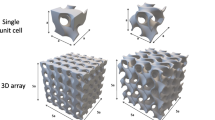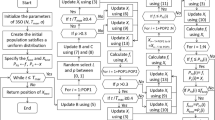Abstract
In the present paper, a plate and frame heat exchanger is considered. Multi-objective optimization using genetic algorithm is developed in order to obtain a set of geometric design parameters, which lead to minimum pressure drop and the maximum overall heat transfer coefficient. Vividly, considered objective functions are conflicting and no single solution can satisfy both objectives simultaneously. Multi-objective optimization procedure yields a set of optimal solutions, called Pareto front, each of which is a trade-off between objectives and can be selected by the user, regarding the application and the project’s limits. The presented work takes care of numerous geometric parameters in the presence of logical constraints. A sensitivity analysis is also carried out to study the effects of different geometric parameters on the considered objective functions. Modeling the system and implementing the multi-objective optimization via genetic algorithm has been performed by MATLAB.








Similar content being viewed by others
Abbreviations
- A 1 :
-
Effective area, m2
- A 1P :
-
Projected area, m2
- A C :
-
Flow area in channel, m2
- b :
-
Meanflow channel gap, m
- C :
-
Heat capacity rate (m C p ), W K−1
- c p :
-
Specific heat of fluid, J kg−1 K−1
- D e :
-
Channel equivalent diameter, m
- D p :
-
Port diameter, m
- f :
-
Friction factor
- G :
-
Mass flux velocity, kg m−2 s−1
- GA:
-
Genetic algorithm
- h :
-
Heat transfer coefficient, W m–2 K−1
- k w :
-
Thermal conductivity, W m−1 K−1
- L c :
-
Total length of compact plates, m
- L eff :
-
Effective length of the flow, m
- L h :
-
Horizontal distance of ports, m
- L v :
-
Vertical distance of ports, m
- L w :
-
Effective plate width, m
- N cp :
-
Number of channels per pass
- N p :
-
Number of passes
- N t :
-
Total number of plates
- P :
-
Plate depth, m
- PHE:
-
Plate heat exchanger.
- ΔP :
-
Pressure drop, N m−2
- P w :
-
Wetted surface, m2
- Re :
-
Reynolds number
- t :
-
Plate thickness, m
- U :
-
Overall heat transfer coefficient, W m2 K
- ε :
-
Effectiveness
- ρ :
-
Density, kg m−3
- μ :
-
Viscosity, N m−1 s−1
- ϕ :
-
Enlargement factor
- c:
-
Cold fluid
- ch:
-
Channel
- h:
-
Hot fluid
- i:
-
Inlet
- o:
-
Outlet
- max:
-
Maximum
- min:
-
Minimum
- p:
-
Port
References
Shah RK, Focke WW (1988) Plate heat exchangers and their design theory. In: Shah RK, Subbarao EC, Mashelkar RA (eds) Heat transfer equipment design. Hemisphere Publishing Corporation, Washington, pp 227–254
Martin H (1996) A theoretical approach to predict the performance of chevron-type plate heat exchangers. Chem Eng Process 35:301–310
Jarzebski AB, Wardas-Koziel E (1985) Dimensioning of plate heat-exchangers to give minimum annual operating costs. Chem Eng Res Des 63(4):211–218
Focke WW (1986) Selecting optimum plate heat-exchanger surface patterns. J Heat Transf 108(1):153–160
Jackson BW, Troupe RA (1966) Plate heat exchanger design by e-NTU method. Chem Eng Progr Symp Ser 62(64):185–190
Kandlikar SG, Shah RK (1989) Multipass plate heat exchangers effectiveness-NTU results and guidelines for selecting pass arrangements. J Heat Transf 111:300–313
Zaleski T, Klepacka K (1992) Plate heat-exchangers method of calculation, charts and guidelines for selecting plate heat-exchangers configurations. Chem Eng Process 31(1):45–56
Wang L, Sunden B (2003) Optimal design of plate heat exchangers with and without pressure drop specifications. Appl Therm Eng 23:295–311
Gut JAW, Pinto JM (2004) Optimal configuration design for plate heat exchangers. Int J Heat Mass Transf 47:4833–4848
Durmus A, Benil B, Kurtbas I, Gul H (2009) Investigation of heat transfer and pressure drop in plate heat exchangers having different surface profiles. Int J Heat Mass Transf 52:1451–1457
Wolfersdorf JV, Achermann E, Weigand B (1997) Shape optimization of cooling channels using genetic algorithms. ASME J Heat Transf 119:380–388
Fabbri G (1997) A genetic algorithm for fin profile optimization. Int J Heat Mass Transf 40(9):2165–2172
Schmit TS, Dhingra AK, Landis F, Kojasoy G (1996) A genetic algorithm optimization technique for compact high intensity cooler design. J Enhanc Heat Transf 3(4):281–290
Tayal MC, Fu Y, Diwekar UM (1999) Optimum design of heat exchangers: a genetic algorithm framework. Ind Eng Chem Res 38:456–467
Xie GN, Sunden B, Wang QW (2008) Optimization of compact heat exchangers by a genetic algorithm. Appl Therm Eng 28(8–9):895–906
Mishra M, Das PK, Sarangi S (2004) Optimum design of crossflow plate-fin heat exchangers through genetic algorithm. Int J Heat Exch 5(2):379–402
Mishra M, Das PK, Sarangi S (2009) Second law based optimisation of crossflow plate-fin heat exchanger design using genetic algorithm. Appl Therm Eng 29:2983–2989
Gholap AK, Khan JA (2007) Design and multi-objective optimization of heat exchangers for refrigerators. Appl Energy 84(12):1226–1239
Hilbert R, Janiga G, Baron R, Thévenin D (2006) Multi-objective shape optimization of a heat exchanger using parallel genetic algorithms. Int J Heat Mass Transf 49(15–16):2567–2577
Kumar H (1984) The plate heat exchanger: construction and design. In: Proceedings of the 1st UK National Conference on heat transfer, University of Leeds, Inst. Chem. Symp., Ser. No. 8.6,1275
Kakac S (2002) Heat exchangers: selection, rating and thermal design, 2nd edn. CRC Press, Boca Raton
Holland J (1975) Adaptation in natural and artificial system. University of Michigan Press, Ann Arbor
Goldberg DE (2000) Genetic algorithms in search and machine learning. Addison-Wesley Longman, Optimization Inc, Boston
Konak A, Coit D, Smith A (2006) Multi-objective optimization using genetic algorithm: a tutorial. Reliab Eng Syst Safety 91:992–1007
Author information
Authors and Affiliations
Corresponding author
Rights and permissions
About this article
Cite this article
Najafi, H., Najafi, B. Multi-objective optimization of a plate and frame heat exchanger via genetic algorithm. Heat Mass Transfer 46, 639–647 (2010). https://doi.org/10.1007/s00231-010-0612-8
Received:
Accepted:
Published:
Issue Date:
DOI: https://doi.org/10.1007/s00231-010-0612-8




